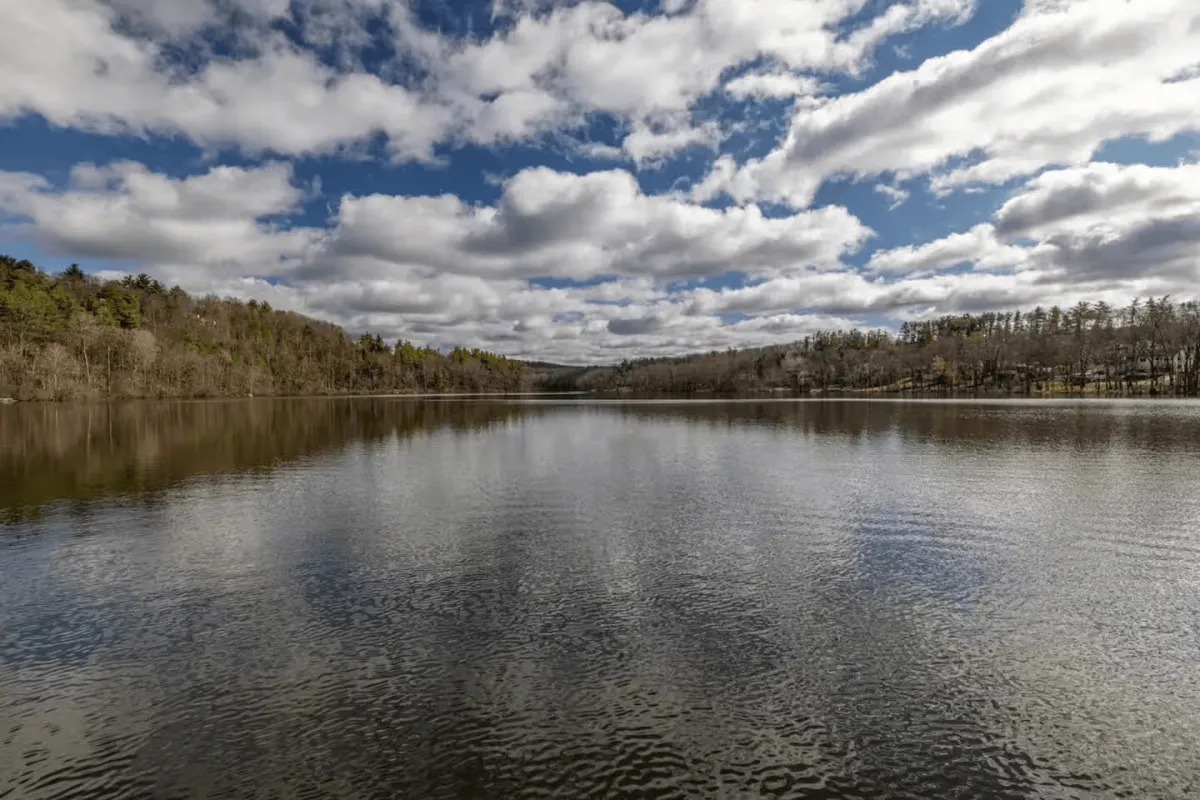The Lake
The Lake at the Blue Mountain
You’ll feel uplifted when you drive into Blue Mountain Lake and view the Lake, right here in our community. Frankly, it’s beautiful.
Doesn’t matter what time of year it is – whether frozen over during the winter months, still somewhat gray right before spring, in the spring with blossoms showing new life everywhere, during summer when all is green, or in the fall with Indian Summer and leaves reinventing themselves in bright colors before dropping upon the Lake.
Note: Even though the Lake is within a private community, a fishing license is required by the Commonwealth of Pennsylvania for every fisherman 16 or more years of age (Fishing License info). The Fish and Game Commission frequently comes on site to inspect for fishing license compliance and proper boat safety such as life preserver use, as the lake is a PA body of water governed by PA Law.

Lake Facts
1. The Lake averages four (4) feet in depth (although there are a couple of deeper parts), and covers 34 acres.
2. The lake is a spring fed lake, so during winter even though it may be, or seem to be, blanketed with ice there will be areas which are not safe due to those springs. Accordingly, no activities are permitted by BML on the ice. (i.e., no ice fishing, skating, sledding, etc.)
3. The lake is a “catch and release lake.” Residents may fish in the lake but are bound to release any fish caught back into the lake. Who made it a catch and release lake? A prior BML Board, long ago. Why? To prevent depletion of fish living there, which if removed could have a detrimental effect on all life in the Lake.
Lake Cleanliness
Yes, we do have algae and we do have both floating and submersed weeds. Both are common in shallow lakes. However, when regularly monitored and treated, algae and weeds do not pose a hazard to the overall water quality or fish.
Periodically throughout the warmer months each year, a company retained by BML named “Tigris Aquatic Services” conducts a survey to check the water quality of the Lake. They are experts at this. If our Lake needs any sort of treatment, Tigris treats it.
We live in beautiful, natural surroundings, centered around a clean, picturesque lake. There is no mystery about why the name of our development is Blue Mountain Lake. After all the Lake is our centerpiece.
Storage for your canoe/kayak
Have Questions?
Iconic Camp Gazebo
Have Questions?
Historical Elements
Have Questions?
Catch & Release lake
In order to prevent overfishing and removal of excessive species of fish from the Blue Mountain Lake, all anglers must practice “Catch and Release.” Anglers are permitted to keep a “trophy” fish and/or children are permitted to keep their first fish or one fish per day (per PA Fishing Regulations), but in most cases the catch should be returned to the lake. If fishing regulations allow, fish that are damaged or bleeding are the ones that should be kept as survival is significantly reduced when fish are injured during the catch.
1. Use Barbless Hooks: Barbless hooks can facilitate the quick removal of the hook from a fish and also reduce the risk of hooking injuries to the angler. Pinching down the barb with needle-nose pliers works.
2. Play Fish Quickly: Try to land your fish as quickly as possible and don’t play the fish to exhaustion.
3. Use a Landing Net: The use of a fine-mesh landing net may aid in reducing the amount of time required to land a fish and keep it from thrashing about in shallow water or on the shore.
4. Keep Fish in Water: It is preferable to remove the hook from a fish you intend to release without taking it out of the water, or at least minimize the amount of time a fish is held out of water.
5. Wet Your Hands: Wet your hands, your net, and other materials that may come in contact with the fish. This reduces the removal of the mucus on the fish and lessens the possibility of bacterial infection.
6. Hold Fish Upside-Down When Removing Hooks: This can often pacify the fish and reduce handling time.
7. Remove Hooks Quickly: Hemostats or long-nose pliers are essential tools for quickly removing hooks. Cutting hooks from a lure may facilitate lure removal in some cases; therefore, wire cutters are a valuable addition to an angler’s hook removal arsenal.
8. Cut the Line: When it is not possible to remove the hook without harming the fish, cut the line. Only a small piece of line should be left on the hook to ease passage through the digestive system. Research has documented that cutting the line can greatly increase the survival of deeply hooked fish.
9. Don’t Touch the Gills: Do not handle fish by placing your fingers in the gill slits. Fish gill filaments are very sensitive and can easily be injured. Fish should be handled by cradling the fish near the head and tail if possible, or by gently holding the fish near the mid-section. Bass can be safely handled by holding the lower jaw, thumb in the mouth and forefinger under the chin.
10. Keep Fish in Water: Allow it to swim away under its own power and if necessary, hold the fish out of the current until it revives
.
11. Prevent Bleeding: Fish that are bleeding from the mouth or gills due to hook removal and handling indicate your catch and release techniques need to improve. Survival is reduced significantly when damage resulting in bleeding occurs.
COMMUNITY NEWS & INFO
Want Updates? Join our eNewsletter!
WE'RE HERE TO HELP
Need Help? Get in Touch!
We'll be happy to help!
Onsite Office Hours: Monday to Thursday: 9am to 4:30pm
Remote Office hours: Friday 9am to 4:30pm
Office: 570-421-2129

